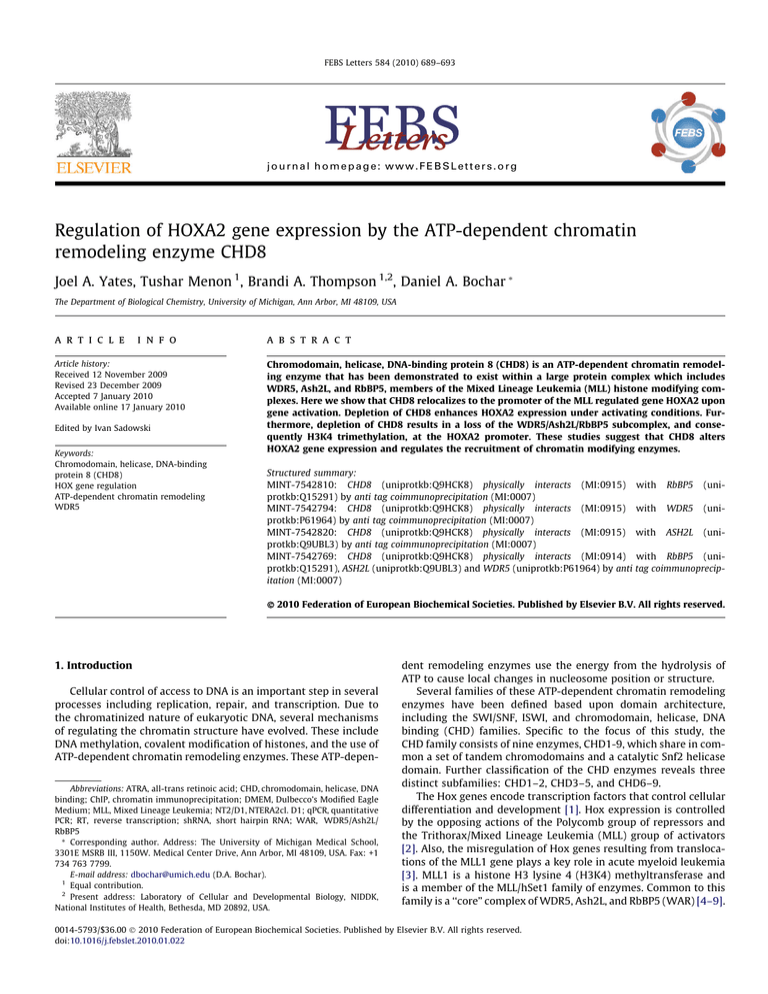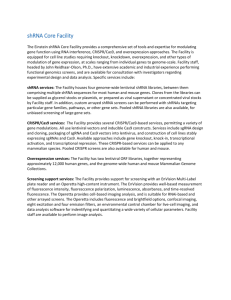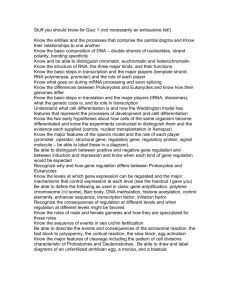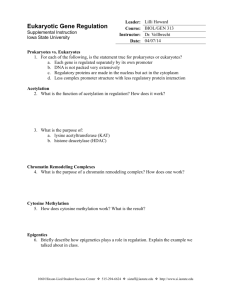
FEBS Letters 584 (2010) 689–693
journal homepage: www.FEBSLetters.org
Regulation of HOXA2 gene expression by the ATP-dependent chromatin
remodeling enzyme CHD8
Joel A. Yates, Tushar Menon 1, Brandi A. Thompson 1,2, Daniel A. Bochar *
The Department of Biological Chemistry, University of Michigan, Ann Arbor, MI 48109, USA
a r t i c l e
i n f o
Article history:
Received 12 November 2009
Revised 23 December 2009
Accepted 7 January 2010
Available online 17 January 2010
Edited by Ivan Sadowski
Keywords:
Chromodomain, helicase, DNA-binding
protein 8 (CHD8)
HOX gene regulation
ATP-dependent chromatin remodeling
WDR5
a b s t r a c t
Chromodomain, helicase, DNA-binding protein 8 (CHD8) is an ATP-dependent chromatin remodeling enzyme that has been demonstrated to exist within a large protein complex which includes
WDR5, Ash2L, and RbBP5, members of the Mixed Lineage Leukemia (MLL) histone modifying complexes. Here we show that CHD8 relocalizes to the promoter of the MLL regulated gene HOXA2 upon
gene activation. Depletion of CHD8 enhances HOXA2 expression under activating conditions. Furthermore, depletion of CHD8 results in a loss of the WDR5/Ash2L/RbBP5 subcomplex, and consequently H3K4 trimethylation, at the HOXA2 promoter. These studies suggest that CHD8 alters
HOXA2 gene expression and regulates the recruitment of chromatin modifying enzymes.
Structured summary:
MINT-7542810: CHD8 (uniprotkb:Q9HCK8) physically interacts (MI:0915) with RbBP5 (uniprotkb:Q15291) by anti tag coimmunoprecipitation (MI:0007)
MINT-7542794: CHD8 (uniprotkb:Q9HCK8) physically interacts (MI:0915) with WDR5 (uniprotkb:P61964) by anti tag coimmunoprecipitation (MI:0007)
MINT-7542820: CHD8 (uniprotkb:Q9HCK8) physically interacts (MI:0915) with ASH2L (uniprotkb:Q9UBL3) by anti tag coimmunoprecipitation (MI:0007)
MINT-7542769: CHD8 (uniprotkb:Q9HCK8) physically interacts (MI:0914) with RbBP5 (uniprotkb:Q15291), ASH2L (uniprotkb:Q9UBL3) and WDR5 (uniprotkb:P61964) by anti tag coimmunoprecipitation (MI:0007)
Ó 2010 Federation of European Biochemical Societies. Published by Elsevier B.V. All rights reserved.
1. Introduction
Cellular control of access to DNA is an important step in several
processes including replication, repair, and transcription. Due to
the chromatinized nature of eukaryotic DNA, several mechanisms
of regulating the chromatin structure have evolved. These include
DNA methylation, covalent modification of histones, and the use of
ATP-dependent chromatin remodeling enzymes. These ATP-depenAbbreviations: ATRA, all-trans retinoic acid; CHD, chromodomain, helicase, DNA
binding; ChIP, chromatin immunoprecipitation; DMEM, Dulbecco’s Modified Eagle
Medium; MLL, Mixed Lineage Leukemia; NT2/D1, NTERA2cl. D1; qPCR, quantitative
PCR; RT, reverse transcription; shRNA, short hairpin RNA; WAR, WDR5/Ash2L/
RbBP5
* Corresponding author. Address: The University of Michigan Medical School,
3301E MSRB III, 1150W. Medical Center Drive, Ann Arbor, MI 48109, USA. Fax: +1
734 763 7799.
E-mail address: dbochar@umich.edu (D.A. Bochar).
1
Equal contribution.
2
Present address: Laboratory of Cellular and Developmental Biology, NIDDK,
National Institutes of Health, Bethesda, MD 20892, USA.
dent remodeling enzymes use the energy from the hydrolysis of
ATP to cause local changes in nucleosome position or structure.
Several families of these ATP-dependent chromatin remodeling
enzymes have been defined based upon domain architecture,
including the SWI/SNF, ISWI, and chromodomain, helicase, DNA
binding (CHD) families. Specific to the focus of this study, the
CHD family consists of nine enzymes, CHD1-9, which share in common a set of tandem chromodomains and a catalytic Snf2 helicase
domain. Further classification of the CHD enzymes reveals three
distinct subfamilies: CHD1–2, CHD3–5, and CHD6–9.
The Hox genes encode transcription factors that control cellular
differentiation and development [1]. Hox expression is controlled
by the opposing actions of the Polycomb group of repressors and
the Trithorax/Mixed Lineage Leukemia (MLL) group of activators
[2]. Also, the misregulation of Hox genes resulting from translocations of the MLL1 gene plays a key role in acute myeloid leukemia
[3]. MLL1 is a histone H3 lysine 4 (H3K4) methyltransferase and
is a member of the MLL/hSet1 family of enzymes. Common to this
family is a ‘‘core” complex of WDR5, Ash2L, and RbBP5 (WAR) [4–9].
0014-5793/$36.00 Ó 2010 Federation of European Biochemical Societies. Published by Elsevier B.V. All rights reserved.
doi:10.1016/j.febslet.2010.01.022
690
J.A. Yates et al. / FEBS Letters 584 (2010) 689–693
Here we report that CHD8 can regulate gene expression at the
HOX locus. CHD8 is able to form a complex with WDR5, Ash2L,
and RbBP5. CHD8 is recruited to HOX promoters and displays a
significant relocalization upon gene activation using all-trans retinoic acid (ATRA). In addition, depletion of CHD8 results in a significant increase of HOXA2 gene expression upon ATRA treatment.
Depletion of CHD8 also results in the loss of Ash2L at the HOXA2
promoter, suggestive of a role for CHD8 in the recruitment of the
WAR complex to the HOXA2 promoter. Taken together, we demonstrate that CHD8 represses ATRA mediated HOXA2 gene expression.
2. Materials and methods
2.1. Cell culture and reagents
Dulbecco’s Modified Eagle Medium (DMEM) (Invitrogen)
with 10% fetal bovine serum (Hyclone) and 1X penicillin–streptomycin–glutamine (Invitrogen) was used to culture NTERA2cl.
D1 (NT2/D1) cells at 37 °C in 10% CO2. For ATRA induction,
cells were treated with 10 lM ATRA while control cells were
left untreated. Cells were grown an additional 24 h before
harvesting.
CHD8 antibodies were previously described [10]. The anti-Flag
M2 (F3165) antibody and rabbit normal IgG immunoglobulin
(I8140) were purchased from Sigma. The anti-RbBP5 (A300109A) and anti-Ash2L (A300-489A) antibodies were purchased
from Bethyl. The anti-WDR5 (22512-100) antibody was purchased
from Abcam. The anti-histone H3 (39163) and the anti-trimethyl
histone H3 lysine 4 (39159) antibodies were purchased from Active Motif. All oligonucleotides were synthesized by Integrated
DNA Technologies (Coralville, IA).
2.2. Chromatin immunoprecipitation (ChIP) assay
ChIP experiments were performed essentially as described in
the ChIP Assay Kit (Millipore) as described previously [10].
2.3. RT-PCR and quantitative PCR (qPCR)
Total RNA was isolated using the RNeasy Kit (Qiagen). Reverse
transcriptase reactions employed random decamers (Ambion)
and Superscript II (Invitrogen) following manufacturers’ protocols.
qPCR analysis employed the indicated primers (Table S1), the iQ
SYBR Green Supermix or iQ Supermix (Bio-Rad), and a MyiQ
Real-Time PCR Detection System (Bio-Rad). All PCR reactions were
performed in triplicate. For RNA analysis, Ct values were normalized to the levels of the Pol III transcribed H1 RNA while ChIP
experiments were expressed relative to input.
2.4. RNAi knockdown experiments
RNAi experiments utilized the UI2-SIBR short hairpin RNA
(shRNA) vectors [11] modified to express the alpha subunit of
the interleukin 2 receptor as a selection marker (Table S1). CHD8
and control shRNA cassettes were described [10]. Ten micrograms
were transfected into cells using lipofectamine 2000 (Invitrogen)
as described by the manufacturer. Twenty four hours post-transfection, cells were either treated with ATRA or not and grown an
additional 24 h before harvesting. Cells were trypsinized and
resuspended in DMEM. Twenty microliters of Dynabeads-CD25
slurry (Invitrogen) were added and rotated at 4 °C for 30 min. Following two PBS washes, the cells were lysed on the beads for RNA
extraction or Western blotting, or, for ChIP experiments, crosslinked on the beads in 1% formaldehyde for 10 min.
3. Results
3.1. CHD8 forms a complex with the core WDR5/Ash2L/RbBP5 complex
Previous work from our lab has identified several CHD8 associated polypeptides [10]. We reported that CHD8 can interact with
WDR5 both in vivo and in vitro. Initially we focused in on WDR5
as this polypeptide has been reported to be part of a MLL histone
methyltransferase complex [4–9], possibly linking chromatin
remodeling and chromatin modification in a single complex. Further evidence for this link was provided by the discovery of
CHD8 in a WDR5-containing complex [9]. As WDR5, Ash2L, and
RbBP5 (WAR) form a subcomplex in the absence of MLL [12,13],
we asked whether CHD8 could also associate with WDR5 in the
context of the subcomplex. This association was tested through
the reconstitution of the complex using a baculovirus expression
system. Co-infection of SF9 cells with WDR5, Ash2L, RbBP5, and
CHD8 followed by affinity purification demonstrated that indeed
CHD8 can associate with WDR5 in the context of the WAR subcomplex (Fig. 1A).
To systematically test the assembly of the WAR/CHD8 complex,
further baculovirus co-infection experiments were performed,
each time omitting one component. As shown in Fig. 1A, the removal of any one of the subunits does not preclude a stable association of the remaining subunits, although omission of Ash2L
results in a diminished quantity of associated RbBP5. To further explore these interactions, pairwise baculovirus co-infection experiments were performed. As shown in Fig. 1B, CHD8 is capable of
interacting directly with each component of the WAR complex.
These results demonstrate that CHD8 has extensive contacts with
the WAR subcomplex, unlike the interactions with MLL that are
dependent on WDR5 [12–15]. The precise means by which these
interactions occur, including interacting domains between each
protein, remains to be elucidated.
3.2. CHD8 is bound to the promoters of the HoxA genes
Previous studies have demonstrated that WAR is recruited to the
HOX locus and is an important regulator of HOX gene expression
[8,9,12,13]. As CHD8 has been shown to interact with WAR [9,10],
we investigated the possibility that CHD8 is also recruited to the
HOX locus where it could function in conjunction with WAR in the
regulation of transcription. The NT2/D1 embryonal carcinoma cell
line was chosen as treatment of these cells with ATRA induces the
expression of many genes, including the HOX genes [16], and ultimately induces cellular differentiation into neuronal-like lineages
[17]. Treatment of NT2/D1 cells with ATRA results in over 500 fold
activation of HOXA1, and 75-, 10-, and 4-fold activations of
HOXA2-A4, respectively (Fig. 2A). This system therefore presents
an opportunity to study the role of CHD8 in Hox gene activation.
To test whether CHD8 is bound to these promoters, we first
examined CHD8 occupancy in uninduced cells using ChIP assays.
We found CHD8 bound to the HOXA1 and HOXA4 promoters,
and to a lesser extent, the HOXA2 and HOXA3 promoters
(Fig. 2B). Due to the upregulation of these HoxA genes upon treatment with ATRA, it is reasonable to suspect that proteins involved
in the regulation of these genes would associate with these promoters in a dynamic manner. Therefore, we compared the occupancy of CHD8 at the HOXA1 through HOXA4 promoters before
and after ATRA treatment. As shown in Fig. 2C, 24 h treatment with
ATRA causes a striking relocalization of CHD8 at the HOXA1
through HOXA4 promoters, with the greatest change being the
20-fold increase of CHD8 at the HOXA2 promoter. This result suggests that CHD8 is indeed functioning in gene regulation at the
HoxA locus.
691
J.A. Yates et al. / FEBS Letters 584 (2010) 689–693
A
flagCHD8
RbBP5
Ash2L
WDR5
-
- + + + +
+ + + + + + + - +
+ + - + +
flagCHD8
RbBP5
Ash2L
WDR5
α-CHD8
250 kD
75 kD
-
+
+
+
+
- + + + +
+ + + + + + + - +
+ + - + +
α-CHD8
250 kD
α-RbBP5
75 kD
75 kD
α-RbBP5
75 kD
α-Ash2L
α-WDR5
37 kD
α-Ash2L
α-WDR5
37 kD
Input
IP:
bea
ds
B
flagCHD8
RbBP5
Ash2L
WDR5
-
+
-
- - - - +
- + + - -
+ + + +
- - - +
- - + - + - -
flagCHD8
RbBP5
Ash2L
WDR5
α-CHD8
250 kD
75 kD
α-RbBP5
75 kD
α-Ash2L
α-WDR5
37 kD
Input
-
+
-
IP:
α-
flag
- - - - +
- + + - -
+ + + +
- - - +
- - + - + - α-CHD8
250 kD
75 kD
α-RbBP5
75 kD
α-Ash2L
α-WDR5
37 kD
IP: α-flag
Fig. 1. CHD8 directly interacts with the core WDR5/Ash2L/RbBP5 complex. (A) Cellular extracts were prepared from SF9 cells following co-infection with the indicated
viruses. Immunoprecipitations were performed with anti-Flag-M2 or control beads. After extensive washing, purified samples were subjected to SDS–PAGE followed by
Western blotting analysis using the indicated antibodies. (B) Pairwise coinfections were performed as in (A) using the indicated baculoviruses.
3.3. CHD8 regulates HoxA gene expression
To directly test the effect of CHD8 upon the regulation of the
HoxA locus, an shRNA strategy was employed to deplete endogenous CHD8. NT2/D1 cells were transfected with control shRNA
constructs or shRNA constructs targeting CHD8. Following selection of transfected cells, cDNA was isolated for analysis by qPCR.
Using this selection protocol, we were unable to detect measureable levels of HoxA gene expression in the absence of ATRA; therefore, all experiments were performed with ATRA treatment.
Depletion of endogenous CHD8 results in an increased expression of HOXA2, while the expression of HOXA1, 3, and 4 does not
change in a statistically significant manner (Fig. 3A). The efficacy
of CHD8 knockdown is demonstrated via Western blot in Fig. 3B.
It is important to compare the increase of HOXA2 transcription
in Fig. 3A to 2C which illustrates that, upon ATRA treatment, the
HOXA2 promoter showed the greatest increase in CHD8 occupancy. Taken together, these data demonstrate that CHD8 indeed
functions in the regulation of HOXA2 gene expression. Furthermore, under activating conditions at the HOXA2 promoter, the normal function of CHD8 appears to be the negative regulation of
HOXA2 gene transcription. This negative effect of CHD8 on HOXA2
expression is consistent with our prior studies of CHD8 and b-catenin mediated transcription where depletion of CHD8 results in an
increase in target gene expression under activating conditions [10].
3.4. CHD8 is required for recruitment of the WAR complex
We have previously shown CHD8 interacts with several proteins including the WAR complex. Because WAR is also involved
in establishing methylation patterns at target genes [8,9,12,13],
we next asked whether CHD8 is involved in the recruitment of
WAR to the promoters of target genes. We tested this hypothesis
via knockdown of CHD8 and chromatin immunoprecipitation as
above. In our hands, antibodies to Ash2L were the most suitable
for these experiments. Because Ash2L has been demonstrated to
be vital for WAR complex function, the absence of Ash2L is indicative of a lack of functional WAR at that gene. As expected, upon
treatment with control shRNA, we are able to detect Ash2L at the
HOXA2 promoter (Fig. 4). However, when CHD8 is depleted via
shRNA treatment, Ash2L is lost from the promoter. This result is
indicative of CHD8 being required for proper WAR complex
recruitment and function. As WAR is a component of multiple histone methyltransferase complexes, CHD8, though the recruitment
of Ash2L, could be required for proper establishment of methylation patterns at target genes.
3.5. CHD8 affects histone H3 methylation patterns at the HOXA2
promoter
As mentioned previously, the WAR complex is known to associate with all members of the SET1 family of histone H3 lysine 4
methyltransferases, playing an important regulatory role in gene
expression, including transcription at the Hox loci [18]. In conjunction with the data demonstrating a requirement for CHD8 in Ash2L
recruitment, a suggested role for CHD8 functioning in the regulation of histone methylation patterns at target genes emerges. We
performed chromatin immunoprecipitation with H3K4me3 antibodies to look for changes in methylation at the HOXA2 promoter
following knockdown of CHD8 and ATRA treatment. Consistent
J.A. Yates et al. / FEBS Letters 584 (2010) 689–693
A
500
400
300
200
100
Ho
Ho
Ho
Ho
xA
xA
xA
xA
4
3
2
1
*
3
2
1
0
Ho
xA
2
-ATRA
B
0.12
shRNA:
0.10
Ho
xA
α-CHD8
50 kD
α-Actin
0.04
37 kD
0.02
Ho
Ho
Ho
Ho
xA
xA
xA
xA
4
3
2
1
25
Fold Change CHD8 ChIP
upon ATRA Treatment
4
+ATRA
250 kD
0.06
Ho
xA
3
0.08
20
Fig. 3. CHD8 regulates expression of the HoxA gene cluster. (A) NT2/D1 cells were
transfected with control shRNA or CHD8 shRNA and induced with ATRA. Following
selection, cells were harvested and total RNA was isolated. Expression of the
indicated genes was analyzed by RT-qPCR. Results are normalized first to a
reference RNA and then to the control shRNA transfection. *P < 0.03 by Student’s ttest. (B) Western blot of control transfected shRNA (GFP) or CHD8 transfected
shRNA cellular lysate. Actin was used as a loading control.
15
10
0.3
5
*
0.24
-5
-10
Ho
Ho
Ho
Ho
xA
xA
xA
xA
3
2
1
4
Fig. 2. CHD8 is bound to the HoxA gene cluster. (A) NT2/D1 cells were treated with
ATRA for 36 h. Cells were harvested and RNA was isolated. Expression of the
indicated genes was analyzed by RT-PCR. (B) Chromatin from NT2/D1 cells was
crosslinked with formaldehyde. Cells were lysed, and ChIPs were performed with
anti-CHD8 antibodies. Bound DNA was detected by quantitative PCR with primer
pairs to the promoter region of the indicated gene. (C) ChIP experiments were
performed using NT2/D1 cells that had been treated with ATRA or not. Results are
expressed relative to untreated cells. Control IgG precipitated samples in all
experiments were less than 0.001% of input and not shown.
with the loss of Ash2L, we found a significant decrease in H3K4me3
levels at the HOXA2 upon depletion of CHD8 (Fig. 5A).
One possible explanation for the decrease in K4 trimethylation
is that CHD8 functions in histone deposition at the HOXA2 promoter, i.e. the loss of observed methylation is due to loss of total
H3 at this promoter. To address this, we again performed chromatin immunoprecipitation experiments after depletion of CHD8 by
shRNA and treatment with ATRA. As shown in Fig. 5B, H3 occupancy at the HOXA2 promoter increases upon CHD8 depletion. This
result suggests that the regulation of transcription by CHD8 occurs
via multiple histone methylation/demethylation events at the promoters of target genes.
4. Discussion
Here, we demonstrate the formation of a CHD8/WDR5/Ash2L/
RbBP5 complex. Also shown is the localization of CHD8 to the
HOXA2 promoter where it acts to negatively regulate expression
under activating conditions. Depletion of CHD8 results in the loss
Percent Input
Percent Input CHD8 ChIP
Ho
xA
1
0.14
0
C
4
Fold Change Expression
Fold Change Expression
600
0
B
A
700
G
FP
CH
D
G 8
FP
CH
D8
692
0.12
*
0.09
0.18
0.06
0.12
0.03
0.06
0
0
CHD8
GFP shRNA
Ash2L
CHD8 shRNA
Fig. 4. CHD8 is required for the recruitment of Ash2L to the HOXA2 promoter. NT2/
D1 cells were transfected with control shRNA or CHD8 shRNA and treated with
ATRA. Following selection of the transfected cells, cells were cross linked using
formaldehyde. Cells were then lysed, following which ChIP experiments were
performed using the indicated antibodies. Bound DNA was detected by quantitative
PCR with primer pairs to the promoter region of HOXA2. Control IgG precipitated
samples were less than 0.001% of input and therefore are not shown. *P < 0.05 by
Student’s t-test.
of Ash2L as well as loss of the H3K4me3 histone mark at the
HOXA2 promoter. These data collectively demonstrate a role for
CHD8 in regulation of HOXA2 gene expression.
We demonstrate a regulatory role for CHD8 at HOXA2, but the
mechanistic details of CHD8 function remain to be fully elucidated.
Though our data demonstrates a role for CHD8 in the maintenance
of promoter environments, the data are inconsistent regarding the
mode of action of CHD8 at this promoter. On one hand, the expression data demonstrates a role for CHD8 in the negative regulation
of target genes (Fig. 3), while ChIP data indicates that CHD8 is necessary for the recruitment and action of a histone modifying complex known to activate transcription at target promoters (Figs. 4
and 5). Further studies into the biological consequences of CHD8
J.A. Yates et al. / FEBS Letters 584 (2010) 689–693
Percent Input
A
2.0
**
0.5
0.3
1.0
References
0.2
0.5
0.1
0
CHD8
GFP shRNA
0.35
**
0.28
Percent Input
Appendix A. Supplementary data
Supplementary data associated with this article can be found, in
the online version, at doi:10.1016/j.febslet.2010.01.022.
0.4
1.5
0
B
*
693
H3K4me3
CHD8 shRNA
1.0
*
0.75
0.21
0.5
0.14
0.25
0.07
0
0
CHD8
GFP shRNA
Total H3
CHD8 shRNA
Fig. 5. CHD8 affects H3K4 trimethylation at the HOXA2 promoter. (A and B) ChIP
experiments were performed as in Fig. 4 using the indicated antibodies. Bound DNA
was detected by quantitative PCR with primer pairs to the promoter region of
HOXA2. Control IgG precipitated samples were less than 0.001% of input and
therefore are not shown. *P < 0.05 by Student’s t-test and **P < 0.01 by Student’s ttest.
loss as well as further biochemical characterization of CHD8 are required to understand the role or roles CHD8 is playing at target
promoters.
CHD8 has been demonstrated to function within the cell in multiple contexts and with a variety of binding partners [19–22]. These
studies, in combination with the current work demonstrate the
important, though cryptic, role of CHD8 within the cell. In addition,
if MLL1 and CHD8 are working to cooperatively regulate genes, the
potential exists for erroneous regulation of CHD8 and leukemogenic MLL1 fusion proteins to exacerbate transcriptional misregulation in cancer. Thus, CHD8 may prove to be an effective target for
novel therapeutics. Further experiments probing the mechanisms
of CHD8 targeting, binding, and in vivo activity are needed to
understand the cellular role of this important remodeling enzyme.
Acknowledgements
We thank R.C. Trievel, J.F. Couture, V. Tremblay, and Y. Dou for
useful reagents. We thank R.P. Kwok, R.C. Trievel, M.D. Uhler for
critical reading of this manuscript. This work was funded by an
American Cancer Society Research Scholar Grant (RSG-07-18901) to D.A.B.
[1] Martinez, P. and Amemiya, C.T. (2002) Genomics of the HOX gene cluster.
Comp. Biochem. Physiol. B: Biochem. Mol. Biol. 133, 571–580.
[2] Ringrose, L. and Paro, R. (2004) Epigenetic regulation of cellular memory by
the polycomb and trithorax group proteins. Annu. Rev. Genet. 38, 413–443.
[3] Andreeff, M. et al. (2008) HOX expression patterns identify a common
signature for favorable AML. Leukemia 22, 2041–2047.
[4] Miller, T., Krogan, N.J., Dover, J., Erdjument-Bromage, H., Tempst, P., Johnston,
M., Greenblatt, J.F. and Shilatifard, A. (2001) COMPASS: a complex of proteins
associated with a trithorax-related SET domain protein. Proc. Natl. Acad. Sci.
USA 98, 12902–12907.
[5] Wysocka, J., Myers, M.P., Laherty, C.D., Eisenman, R.N. and Herr, W. (2003)
Human Sin3 deacetylase and trithorax-related Set1/Ash2 histone H3-K4
methyltransferase are tethered together selectively by the cell-proliferation
factor HCF-1. Genes Dev. 17, 896–911.
[6] Goo, Y.H. et al. (2003) Activating signal cointegrator 2 belongs to a novel
steady-state complex that contains a subset of trithorax group proteins. Mol.
Cell Biol. 23, 140–149.
[7] Yokoyama, A., Wang, Z., Wysocka, J., Sanyal, M., Aufiero, D.J., Kitabayashi, I.,
Herr, W. and Cleary, M.L. (2004) Leukemia proto-oncoprotein MLL forms a
SET1-like histone methyltransferase complex with menin to regulate Hox
gene expression. Mol. Cell Biol. 24, 5639–5649.
[8] Wysocka, J. et al. (2005) WDR5 associates with histone H3 methylated at K4
and is essential for H3 K4 methylation and vertebrate development. Cell 121,
859–872.
[9] Dou, Y. et al. (2005) Physical association and coordinate function of the H3 K4
methyltransferase MLL1 and the H4 K16 acetyltransferase MOF. Cell 121, 873–
885.
[10] Thompson, B.A., Tremblay, V., Lin, G. and Bochar, D.A. (2008) CHD8 is an ATPdependent chromatin remodeling factor that regulates beta-catenin target
genes. Mol. Cell Biol. 28, 3894–3904.
[11] Chung, K.H., Hart, C.C., Al-Bassam, S., Avery, A., Taylor, J., Patel, P.D., Vojtek,
A.B. and Turner, D.L. (2006) Polycistronic RNA polymerase II expression
vectors for RNA interference based on BIC/miR-155. Nucleic Acids Res. 34, e53.
[12] Dou, Y., Milne, T.A., Ruthenburg, A.J., Lee, S., Lee, J.W., Verdine, G.L., Allis, C.D.
and Roeder, R.G. (2006) Regulation of MLL1 H3K4 methyltransferase activity
by its core components. Nat. Struct. Mol. Biol. 13, 713–719.
[13] Steward, M.M., Lee, J.S., O’Donovan, A., Wyatt, M., Bernstein, B.E. and
Shilatifard, A. (2006) Molecular regulation of H3K4 trimethylation by ASH2L,
a shared subunit of MLL complexes. Nat. Struct. Mol. Biol. 13, 852–854.
[14] Patel, A., Vought, V.E., Dharmarajan, V. and Cosgrove, M.S. (2008) A conserved
arginine-containing motif crucial for the assembly and enzymatic activity of
the mixed lineage leukemia protein-1 core complex. J. Biol. Chem. 283,
32162–32175.
[15] Song, J.J. and Kingston, R.E. (2008) WDR5 interacts with mixed lineage
leukemia (MLL) protein via the histone H3-binding pocket. J. Biol. Chem. 283,
35258–35264.
[16] Mavilio, F., Simeone, A., Boncinelli, E. and Andrews, P.W. (1988) Activation of
four homeobox gene clusters in human embryonal carcinoma cells induced to
differentiate by retinoic acid. Differentiation 37, 73–79.
[17] Andrews, P.W. (1984) Retinoic acid induces neuronal differentiation of a
cloned human embryonal carcinoma cell line in vitro. Dev. Biol. 103, 285–293.
[18] Hess, J.L. (2004) MLL: a histone methyltransferase disrupted in leukemia.
Trends Mol. Med. 10, 500–507.
[19] Ishihara, K., Oshimura, M. and Nakao, M. (2006) CTCF-dependent chromatin
insulator is linked to epigenetic remodeling. Mol. Cell 23, 733–742.
[20] Nishiyama, M. et al. (2009) CHD8 suppresses p53-mediated apoptosis through
histone H1 recruitment during early embryogenesis. Nat. Cell Biol. 11, 172–
182.
[21] Rodriguez-Paredes, M., Ceballos-Chavez, M., Esteller, M., Garcia-Dominguez,
M. and Reyes, J.C. (2009) The chromatin remodeling factor CHD8 interacts
with elongating RNA polymerase II and controls expression of the cyclin E2
gene. Nucleic Acids Res. 37, 2449–2460.
[22] Yuan, C.C., Zhao, X., Florens, L., Swanson, S.K., Washburn, M.P. and Hernandez,
N. (2007) CHD8 associates with human Staf and contributes to efficient U6
RNA polymerase III transcription. Mol. Cell Biol. 27, 8729–8738.






